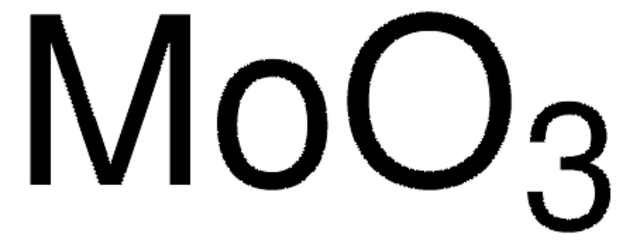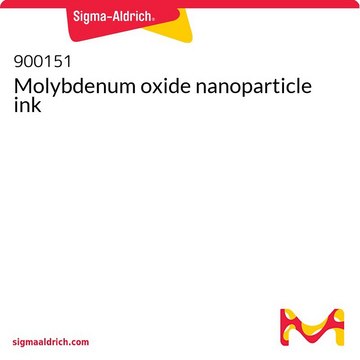Alle Fotos(3)
Wichtige Dokumente
M0753
Molybdän(VI)-oxid
ReagentPlus®, ≥99.5%
Synonym(e):
Molybdänsäureanhydrid
Anmeldenzur Ansicht organisationsspezifischer und vertraglich vereinbarter Preise
Alle Fotos(3)
About This Item
Lineare Formel:
MoO3
CAS-Nummer:
Molekulargewicht:
143.94
EG-Nummer:
MDL-Nummer:
UNSPSC-Code:
12352303
PubChem Substanz-ID:
NACRES:
NA.55
Assay:
≥99.5%
Form:
crystals
Empfohlene Produkte
Qualitätsniveau
Produktlinie
ReagentPlus®
Assay
≥99.5%
Form
crystals
Eignung der Reaktion
reagent type: catalyst
core: molybdenum
mp (Schmelzpunkt)
795 °C (lit.)
Kationenspuren
NH4+: ≤0.02%
SMILES String
O=[Mo](=O)=O
InChI
1S/Mo.3O
InChIKey
JKQOBWVOAYFWKG-UHFFFAOYSA-N
Suchen Sie nach ähnlichen Produkten? Aufrufen Leitfaden zum Produktvergleich
Anwendung
Used in the solid state synthesis of a remarkable ternary, reduced molybdenum oxide, Pr4Mo9O18, whose structure contains previously unknown Mo7, Mo13 and Mo19 clusters. The new cluster product is a small band gap semiconductor.
Vorstufe zu LAMOX schnellen Ionen-Leitern und Supraleitern.
Rechtliche Hinweise
ReagentPlus is a registered trademark of Merck KGaA, Darmstadt, Germany
Signalwort
Warning
H-Sätze
Gefahreneinstufungen
Carc. 2 - Eye Irrit. 2 - STOT SE 3
Zielorgane
Respiratory system
Lagerklassenschlüssel
11 - Combustible Solids
WGK
WGK 1
Flammpunkt (°F)
Not applicable
Flammpunkt (°C)
Not applicable
Hier finden Sie alle aktuellen Versionen:
Besitzen Sie dieses Produkt bereits?
In der Dokumentenbibliothek finden Sie die Dokumentation zu den Produkten, die Sie kürzlich erworben haben.
Kunden haben sich ebenfalls angesehen
Patrick R Brown et al.
Nano letters, 11(7), 2955-2961 (2011-06-15)
The ability to engineer interfacial energy offsets in photovoltaic devices is one of the keys to their optimization. Here, we demonstrate that improvements in power conversion efficiency may be attained for ZnO/PbS heterojunction quantum dot photovoltaics through the incorporation of
Seiichiro Murase et al.
Advanced materials (Deerfield Beach, Fla.), 24(18), 2459-2462 (2012-04-11)
An MoO(3) film spin-coated from a solution prepared by an extremely facile and cost-effective synthetic method is introduced as an anode buffer layer of bulk-heterojunction polymer photovoltaic devices. The device efficiency using the MoO(3) anode buffer layer is comparable to
Design of transparent anodes for resonant cavity enhanced light harvesting in organic solar cells.
Nicholas P Sergeant et al.
Advanced materials (Deerfield Beach, Fla.), 24(6), 728-732 (2012-01-04)
Claudio Girotto et al.
ACS applied materials & interfaces, 3(9), 3244-3247 (2011-08-13)
We report on a sol-gel-based technique to fabricate MoO(3) thin films as a hole-injection layer for solution-processed or thermally evaporated organic solar cells. The solution-processed MoO(3) (sMoO(3)) films are demonstrated to have equal performance to hole-injection layers composed of either
Yu-Zhan Wang et al.
The Journal of chemical physics, 134(3), 034706-034706 (2011-01-26)
The electronic structures at the MoO(3)∕Co interface were investigated using synchrotron-based ultraviolet and x-ray photoelectron spectroscopy. It was found that interfacial chemical reactions lead to the reduction of Mo oxidation states and the formation of Co-O bonds. These interfacial chemical
Unser Team von Wissenschaftlern verfügt über Erfahrung in allen Forschungsbereichen einschließlich Life Science, Materialwissenschaften, chemischer Synthese, Chromatographie, Analytik und vielen mehr..
Setzen Sie sich mit dem technischen Dienst in Verbindung.

















